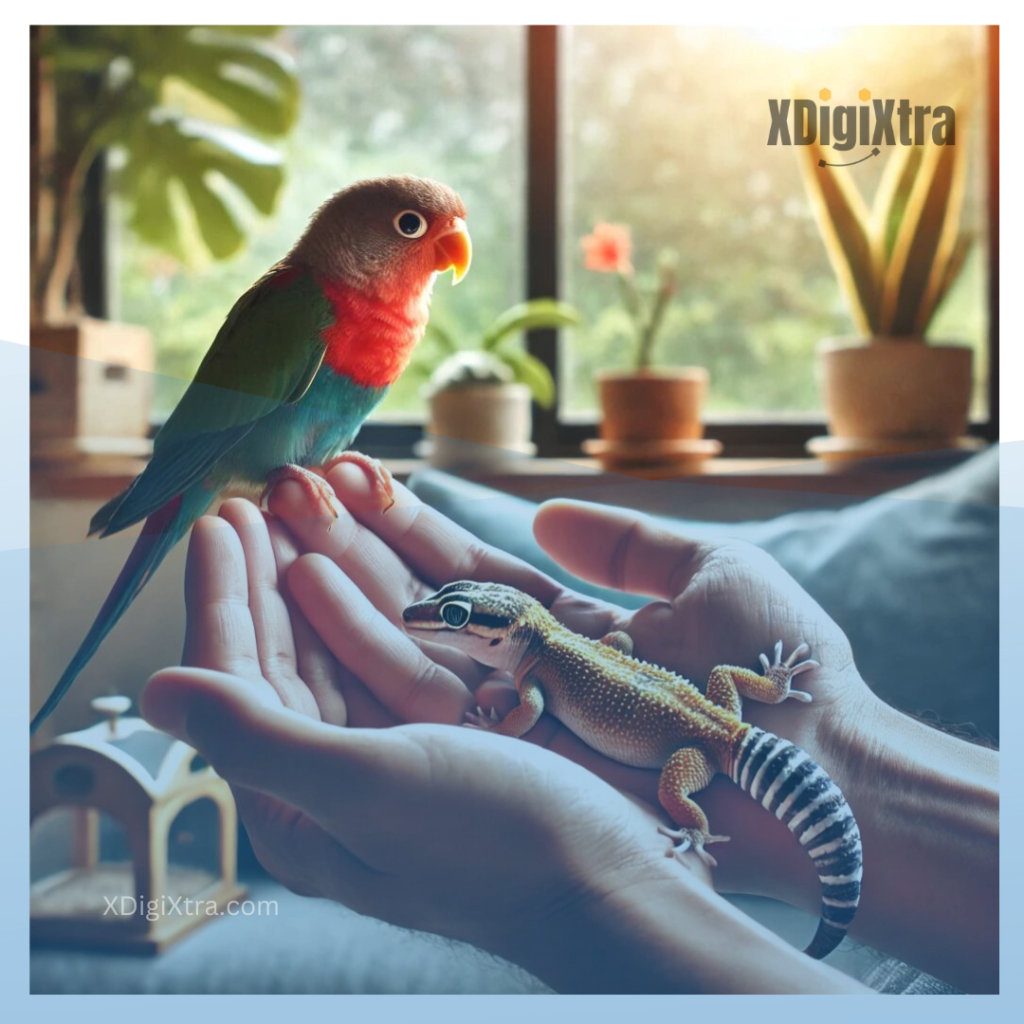
Learn how to care for reptiles and exotic birds at home with essential tips on handling, feeding, and creating the perfect environment for your unique pets.
If you’ve ever thought about bringing home a reptile or an exotic bird, you’re in for a fascinating experience! These rare pet species offer so much joy and personality, but they also require special attention. Let’s dive into the essentials of caring for exotic pets, whether they’re reptiles or birds, and how we can give them the best life possible.
1. Understanding Your Exotic Pet’s Nature
Before bringing home any reptile or bird, it’s important to understand their natural behavior. Reptiles like geckos or snakes are cold-blooded, so they rely on their environment to regulate their body temperature. Caring for reptiles means ensuring they have access to both warm and cool areas in their enclosure. On the other hand, birds like parrots or cockatoos are highly social and love mental stimulation, making interaction a big part of their care.
For example, my friend Sam has a green iguana, and it’s fascinating to see how he sets up UVB lighting in the tank to mimic the sun. This light helps with the iguana’s bone health, something that might be overlooked by new owners.
2. Setting Up the Perfect Environment
Now, let’s talk about creating the perfect habitat. Reptile pet care essentials include an enclosure with the right temperature gradient. For a snake or gecko, you need a basking spot, which can be achieved using heat lamps. And don’t forget to add hiding spots and foliage to give them a secure, natural feel.
When it comes to birds, especially **exotic bird care basics**, they need space to spread their wings, literally! A large cage with perches at different levels is crucial. I recently visited a friend who owns a macaw, and one of the things I noticed was the variety of perches and toys in the cage. Her bird spends hours climbing and chewing on different textures, which helps keep it entertained.
3. Feeding Your Exotic Pets
Feeding is another key aspect of pet care for reptiles and birds. Reptiles usually have very specific dietary needs, like crickets, mealworms, or leafy greens. Make sure to feed them a diet that mirrors what they’d eat in the wild. For instance, Sam’s iguana eats mostly vegetables like collard greens and squash, while his gecko enjoys live insects.
Birds, on the other hand, often require a mix of seeds, pellets, and fresh fruits. When I adopted a cockatiel, I found that offering it fresh fruits and vegetables in addition to birdseed made a huge difference in its energy levels and overall health.
4. Handling Your Special Pets with Care
It’s essential to know how to properly handle these animals. Birds can be socialized to sit on your hand, but reptiles are different. Many reptiles, like snakes or bearded dragons, prefer to be observed rather than handled frequently.
For example, when I handle my pet ball python, I make sure to do so gently and avoid sudden movements. Snakes can become stressed easily, so giving them a calm, controlled environment is vital. Similarly, how to care for exotic birds at home requires knowing when they want interaction and when they need space. If you’ve ever seen a parrot puff up its feathers, it’s signaling it might not be in the mood for attention.
5. Best Practices for Long-Term Care
Let’s talk about some exotic pet care tips to ensure their long-term health. For reptiles, regular tank cleaning is necessary to prevent bacteria build-up. I schedule a deep clean of my python’s tank every two weeks, ensuring its living space stays hygienic. I also monitor humidity levels, as snakes often require a moist environment for proper shedding.
For birds, regular cage cleaning and offering a variety of toys keep them mentally stimulated. Parrots, for instance, can get bored quickly, which can lead to destructive behavior like feather plucking. My friend who owns a cockatoo changes its toys regularly and even rotates them to keep things fresh.
6. Real-Life Example: Managing Special Pets Together
A friend of mine owns both a bearded dragon and a pair of lovebirds, and while it might sound challenging, she’s found a balance. The key to her success? Knowing each species’ specific needs. Her dragon enjoys basking in the sun for hours, while her lovebirds are happiest chirping away in the morning.
In this case, she makes sure to keep the temperature in her home comfortable for both species. She also places the birdcage far from the reptile tank to avoid stressing either pet. It’s fascinating to see how handling such diverse animals comes down to understanding their behavior and environment.
7. Final Thoughts: Getting Comfortable with Exotic Pet Care
Caring for reptiles and exotic birds can be an incredibly rewarding experience if you’re prepared for the responsibility. Whether it’s adjusting the temperature in your reptile’s tank or ensuring your bird has mental stimulation, handling exotic pets requires a thoughtful approach. We must consider each species’ needs and offer the best care possible for them to thrive.
In the end, these animals might be unique, but they can become just as much a part of your family as any dog or cat. So, if you’re up for the challenge, there’s no reason not to explore the world of exotic pet care!